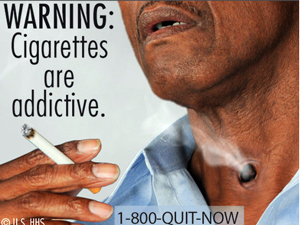Adult smoking rate edges down slightly
By Lindsey Tanner AP Medical Writer | Last updated: Sep 30, 2011 - 10:21:48 AMWhat's your opinion on this article?

Image: SmokeFree.gov
|
According to a Centers for Disease Control and Prevention report released Tuesday, 19.3 percent of adults said they smoked last year, down from about 21 percent in 2005. The rate for smoking 30 or more cigarettes daily dropped to about 8 percent from almost 13 percent during the same time period.
The report only compared last year with 2005 and says the decline means 3 million fewer adults were smoking. The CDC earlier reported that the 2009 rate was 20.6 percent and rates fluctuated during the five-year period.
The 5-year decline was much slower than a drop seen over the previous 40 years, said Dr. Thomas Frieden, director of the Atlanta-based agency. He said any decline is a good step, but also said tobacco use remains a significant health burden.
``About half of all smokers will be killed by tobacco if they don't quit,'' Frieden said during a news briefing.
``You don't have to be a heavy smoker or a long-time smoker to get a smoking-related disease or have a heart attack or asthma attack,'' Frieden said. ``The sooner you quit smoking, the sooner your body can begin to heal.''
The 2010 numbers are based partly on face-to-face interviews with almost 27,000 Americans aged 18 and older.
Declines in federal and state taxes on cigarettes and new clean air laws are among reasons for the drop, said Dr. Tim McAfee, director of the CDC's office on smoking and health.
Those positive trends have been offset by efforts from the tobacco industry, including offering discounts to consumers, McAfee said.
If the slowed rate of decline continues, adult smoking rates will reach 17 percent by 2020, far higher than the government's goal of no more than 12 percent, the CDC report said.
Government efforts to further reduce smoking rates include proposed graphic cigarette packaging labels, which are being challenged in court by the tobacco industry.
Frieden said evidence from states with strong anti-smoking programs show that tobacco control can be effective. Rates are far below the national average in states with the strongest tobacco control programs, he noted. States with the lowest rates are Utah, at 9 percent, and California, 12 percent, the CDC report found.
In a statement, American Heart Association CEO Nancy Brown said the report shows some successes but also continued disparities. Smoking was most common among low-income, less educated adults and among American Indians and Alaska natives.
Matthew Meyers, president of the Campaign for Tobacco-Free Kids, a Washington-based advocacy group, said in a statement that it's too soon to declare victory when nearly one in five adults still smokes.
Related News
Tobacco company guilty of giving free cigarettes to children (FCN, 01-12-2011)
Cigarette Smoking and Lung Cancer.. A Deadly Mix (FCN, 11-20-2008)
INSIDE STORIES AND REVIEWS
-
-
About Harriett ... and the Negro Hollywood Road Show
By Rabiah Muhammad, Guest Columnist » Full Story -
Skepticism greets Jay-Z, NFL talk of inspiring change
By Bryan 18X Crawford and Richard B. Muhammad The Final Call Newspaper @TheFinalCall » Full Story -
The painful problem of Black girls and suicide
By Charlene Muhammad -National Correspondent- » Full Story -
Exploitation of Innocence - Report: Perceptions, policies hurting Black girls
By Charlene Muhammad -National Correspondent- » Full Story -
Big Ballin: Big ideas fuel a father’s Big Baller Brand and brash business sense
By Bryan Crawford -Contributing Writer- » Full Story






 Click Here Stay Connected!
Click Here Stay Connected!








